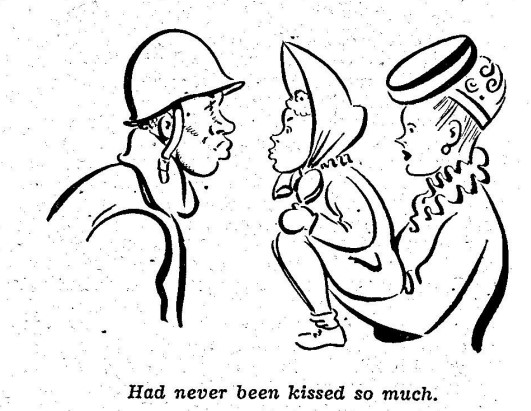By Robin Washington
November 10, 2023
With the world on edge over Israel and Gaza and the continuing devastation in Ukraine, it’s hard to imagine anyone wanting to claim any association with war.
But it was a much different world in 1945, when a Baltimore-based Black newspaper chain published “This is our war: Selected Stories of Six War Correspondents Who Were Sent Overseas by the Afro-American Newspapers” to cover World War II.
And it’s significant enough for the Afro-American to republish it.
“People ask me, ‘That’s an old book. Why are you reprinting it?'” said Frances “Toni” Draper, the CEO and president of the 131-year-old Black newspaper chain, which released a new edition of the 214-page pocket-size booklet on Tuesday, ahead of Veterans Day.
The reprinting, with a new introduction but otherwise preserving the original text and illustrations, is in part to celebrate the 75th anniversary of the desegregation of America’s armed forces, Draper said. But it’s also to honor “the sacrifice of these people (and to tell) who they were and what they did” in fighting Nazism while facing violent and crushing racism at home and abroad in the segregated armed forces.
In the service, much of that hostility was imposed by white commanding officers subscribing to the notion that Blacks weren’t cut out for the military, despite evidence to the contrary in every conflict from the American Revolution to World War I.
Intent on disproving that was Draper’s grandfather, Afro-American Publisher Carl Murphy. The son of a Civil War sergeant, he was determined to send Black correspondents to cover the Black troops fairly.
“The Afro-American sent none of its writers abroad to cover World War I,” Murphy wrote in the introduction, dated Dec. 15, 1944. He went on to thank a handful of Black officials in President Franklin Roosevelt’s administration who advocated for embedding Black journalists with the troops.
Before the correspondents could be deployed, however, Black recruits had to fight for the right to fight.
While it may seem unthinkable by today’s standards, Black draftees were rejected in the early years of the war, Dartmouth University Professor Matthew F. Delmont writes in “Half American,” published last year by Viking Press. That rejection came even as America called for more manpower following the Japanese attack on Pearl Harbor in December 1941. Until 1942, the Marine Corps refused Blacks altogether, going back to its founding in 1798.
The other branches of the armed services strictly segregated Blacks, assigning most to menial, non-combat duty. Even so, Black newspapers championed their recruitment, with Pittsburgh Courier Editor Robert Vann editorializing, “We plead, ‘Let us die for America if need be!’ ”
The Black papers were equally vociferous in fighting segregation at home, mounting the Double V campaign — standing for victory against the Axis and victory at home against Jim Crow.
Ultimately, 27 Black war correspondents were dispatched to every American theater of the war, writing for the Afro-American’s editions then in five cities, as well as the Chicago Defender, Pittsburgh Courier, New York Amsterdam News and other Black papers. (Independently, Homer Smith, an African American journalist living as an expatriate in the Soviet Union, covered the Eastern front for both the Associated Negro Press and the Associated Press.)
Ollie Stewart, who began writing for the Afro-American in 1934, covering Black troops training stateside, was the first to receive War Department accreditation. In July 1942, he headed to North Africa for the Allies’ pursuit of German tank commander Erwin Rommel, then followed the invasion of Italy in which the Army Air Force’s all-Black 99th Squadron played a part.
Many white officers dismissed the Black fighter pilots as experimental at best, if not inferior, but Stewart dispelled those stereotypes.
“Wednesday, Sept. 9th, the boys destroyed eighty-three German planes on an airfield at Grosz-Wardein, Rumania [now Romania], Stewart wrote in 1942. “Their feat was praised by the 15th (Army Air Force) commanders as ‘the most effective machine-gunning of German aircraft on the ground on an airfield ever to be carried out in the Mediterranean Theatre.’ “
Today known as the Tuskegee Airmen, the pilots collectively received a Congressional Gold Medal in 2007 and have been celebrated and immortalized in popular media, including the 2012 Hollywood movie “Red Tails.”
But other Black units struggled under overtly racist white commanding officers. Delmont quotes the white division commander of the Black 92nd Infantry Division saying, “No white man wants to be accused of leaving the battle line. The Negro doesn’t care.” The white press could be equally demeaning, with Newsweek berating the Army’s use of Black troops as “more productive of disappointment and failure than anything else.”
The Black correspondents countered with effusive language that, though commonplace in the journalistic parlance of the day, may today seem over the top or even propagandistic.
“Stories of heroic deeds by colored troops have come to me from every angle since my arrival on a Normandy beachhead,” Stewart wrote.
Draper puts it in perspective. “It’s not so much propaganda, it’s balancing the scale,” she says.
“There was so much imbalance about who they were, about what our contributions were. I think you have to put it in context with the way Black newspapers reported on our communities in general. That happens today as well. Given the denigration of our communities in general, the Black press was and still is the trusted voice that said, ‘Hey, wait a minute. You just can’t paint us in that negative light, with such a broad brush for everything.’ That’s not who we are.”
Using the easy-chair style of writing of their time, which sometimes took the pizzazz out of gruesome or dramatic events, the correspondents used similar praise to describe the work of the overwhelming majority of the Black troops who were assigned to support roles rather than direct combat.
“Keeping supplies moving to the front is now in the hands of fifty-three colored motor transport companies,” Stewart wrote from France after D-Day in 1944. “The 30,000 men and 19,000 vehicles constitute the largest concentration of motor transportation under one single command in the world.
“Everything needed for the fighting men is unloaded on the beaches to be hauled to the front. If for one single day, our soldiers had been forced to march on empty stomachs, or lean on their rifles because they had no bullets, we would have been thrown pell-mell back into the sea. But we haven’t been thrown back because our (motor transport) boys now keep ’em rolling.
“Now that the Army admits that the man behind the wheel kills more men than the man behind the gun, Hitler can be told what gives the Allied Armies the impetus to tear his divisions to shreds at such a rapid rate.”
The Black correspondents also noted when those support troops took up arms, following the lead of Navy messman Dorie Miller’s manning artillery he had never used to shoot down Japanese Zeroes during the attack at Pearl Harbor.
“Cpl. John Hawkins of Pine Bluff, Ark., … shot down a German plane on D-Day while landing under fire with a trucking company,” Stewart wrote.
The reference to Cpl. Hawkins’ hometown was not an accident, said Draper.
“Oh yeah,” she said. “The stories that stand out the most for me are the ones that are personal, where people ask, ‘Can you send a message to my mom, my dad, my sister, my brother? Here’s my address.’”
The volume is replete with those details, down to the streets and house numbers, from locations as remote as Alaska, where correspondent Herbert Frisby (pictured) chronicled Black troops building the Alcan Highway as a supply route to the Soviet Union. Ironically, Frisby himself was discovered by a relative when I asked former Wall Street Journal White House correspondent Michael Frisby if they were related.
“I didn’t know of him,” Michael Frisby wrote back initially, “but I am related to Frisbys from Baltimore, including Herbert Frisby, who was the second Black man to go to the North Pole.”
That’s him, I wrote back. After his time in Alaska, it was logical that he’d decide to go to the pole.
“Damn! You hit it!” he replied after speaking with a family historian who provided a full biography, including Arctic exploration, of his now-found late cousin.
Stories like that are another reason for reprinting the book, says Draper. “You may find one of your cousins, and somebody may still be owed some GI benefits,” she said — not entirely joking.
Still, Draper says she understands that today’s views on war, especially with horrific conflicts bringing the major powers to the brink of global catastrophe, may make it difficult for younger people to appreciate the struggles of past generations. And even though she remembers being aware of the book as a small child, it was not something that interested her as a teen during the Vietnam War years.
Yet the book is a time capsule offering a look, if not a roadmap, to overcoming social wrongs. It also addresses journalistic practices that have changed over the years, such as why the correspondents wore military uniforms.
“A correspondent has the rank of captain,” wrote Elizabeth Murphy Phillips, Draper’s aunt, describing herself as “the first woman overseas war correspondent.”
“My baggage includes a typewriter, Army Air Forces overseas bag, which is packed to the gills, and a musette bag, gift from the local NAACP, all of which contain GI clothing; no fancy stuff!
“Other than that, I’ll probably have to wear trousers like the average male soldier.”
Phillips’ chapter is titled “3,000 Miles to a Hospital,” detailing how she was sidelined after taking ill shortly after arriving in London.
Two months before, Phillips wrote, she visited Maryland’s Eastern Shore “where a mob had just burned the home and tavern of a colored business man and then forced his family of eight to flee for their lives.
“We walked amid angry white people who, I’m convinced, would have attacked us were it not for the presence of the State police. A trip to the European Theatre of War could never be any worse.”
That leads to the second V of the Double V campaign: Victory over Jim Crow at home. The Black press intensified the campaign during and after the war, especially when returning Black GIs were harassed and treated violently for wearing their uniforms in Southern towns.
One of the early Black civil rights actions of the period was the 1947 Journey of Reconciliation, the first freedom ride, in which 16 white and Black men traveled through the South seeking to enforce a Supreme Court ruling the year before, which outlawed segregation in interstate travel.
Invited as observers on the two-week trip were two Black reporters: Stewart for the Afro-American and Lem Graves of the Pittsburgh Courier, who covered the Mediterranean Theatre for the Norfolk Journal & Guide.
War correspondents both.


 WordPress
WordPress